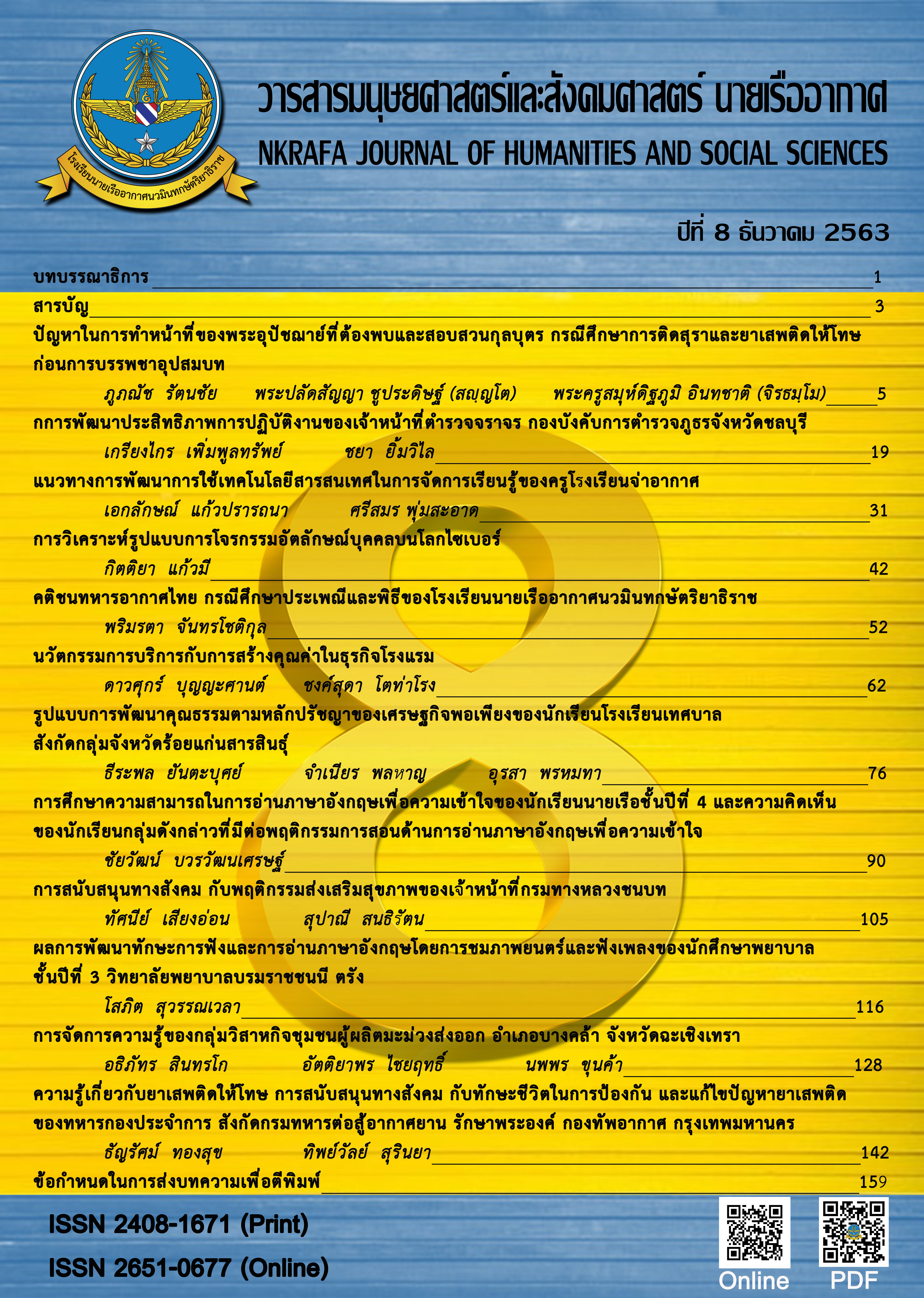The Study on English Reading Comprehension Ability of the Fourth-Year Naval Cadets and their Opinions towards Teaching Behaviors in Instructor of English Reading Course
Main Article Content
Abstract
The objectives of this research were to 1) analyze confirmatory factor analysis of the fourth-year naval cadets’ English reading comprehension ability 2) study the fourth-year naval cadets’ English reading comprehension ability and 3) study the fourth-year naval cadets’ opinions towards English reading comprehension teaching behaviors. The population was sixty-nine naval cadets selected from the fourth-year level studying their final semester in academic year 2019. The research instruments were two rating-scale questionnaires and an achievement test. The data were statistically analyzed by mean (), standard deviation (), confirmatory factor analysis (CFA) and one-way analysis of variance (F-test). The findings were as follows: 1) factors of the fourth-year naval cadets’ English reading comprehension ability comprised three components: Factor 1 literal comprehension including 7 indicators, Factor 2 inferential comprehension including 7 indicators and Factor 3 critical comprehension including 7 indicators. There were totally 21 indicators with a range of factors loadings from 0.40 to 0.87, Eigen values from 5.24-20.38 and a cumulative percentage variance at 87.96. 2) the study of the fourth-year naval cadets’ English reading comprehension ability revealed that the average test score was overall at a moderate level. When considering specifically, the average test score of management science section was the highest at a relatively good level, followed by hydrographic engineering section which was at a moderate level. On the other hand, the average test score of hydrographic engineering section was the least at a minimum criterion. 3) the study of the fourth-year naval cadets’ opinions towards English reading comprehension teaching behaviors was found that the mean of English reading comprehension teaching behaviors in all aspects were overall at a moderate level, excluding a personality aspect with its mean at a high level. The result of one-way analysis of variance revealed that there were no statistically significant differences at .05 level in English reading comprehension teaching behaviors when comparing between the section which the fourth-year naval cadets were studying in.
Article Details
บทความที่ได้รับการตีพิมพ์เป็นลิขสิทธิ์ของวารสารมนุษยศาสตร์และสังคมศาสตร์ นายเรืออากาศ
ข้อความที่ปรากฎในบทความแต่ละเรื่องในวารสารวิชาการเล่มนี้ เป็นความคิดเห็นส่วนตัวของผู้เขียนแต่ละท่าน ไม่เกี่ยวข้องกับโรงเรียนนายเรืออากาศฯ และคณาจารย์ท่านอื่น ๆในโรงเรียนนายเรืออากาศฯ แต่อย่างใด ความรับผิดชอบขององค์ประกอบทั้งหมดของบทความแต่ละเรื่องเป็นของผู้เขียนแต่ละท่าน หากมีความผิดพลาดใด ๆ ผู้เขียนแต่ละท่านจะรับผิดชอบบทความของตนเองแต่เพียงผู้เดียว
References
ฉวีวรรณ คูหาภินันท์, เทคนิคการอ่าน, กรุงเทพฯ: ศิลปบรรณาการ, 2542.
Anderson, N. J, Exploring Second Language Reading, Toronto: Heinle & Heinle Publishers, 1999.
Eskey, “Teaching Advanced Reading: The Structural Problem”, 2 (August-September), 210-215, 1996.
Allen, E. D. & Valette, R. M., Classroom Techniques: Foreign Language and English as a Second Language,
New York: Harcourt Brace Javanovich Inc, 1989.
ถวิล มาตรเลี่ยม, “คุณภาพครูกับคุณภาพการสอน”, วารสารวิชาการ, ปีที่ 2, ฉบับที่ 4, หน้า 15-16, เมษายน, 2542.
สงัด อุทรานันท์, เทคนิคการจัดการเรียนการสอนอย่างเป็นระบบ, กรุงเทพ ฯ: มิตรสยาม, 2532.
สํานักงานคณะกรรมการการศึกษาขั้นพื้นฐาน, แนวปฏิบัติการจัดการศึกษาของสถานศึกษานิติบุคคลในสังกัด
สํานักงานคณะกรรมการการศึกษาขั้นพื้นฐาน, กรุงเทพฯ: โรงพิมพ์สํานักงานพระพุทธศาสนาแห่งชาติ, 2549.
บุญชม ศรีสะอาด, การวิจัยทางการวัดผลและประเมินผล, กรุงเทพฯ: สุวีริยาสาส์น, 2540.
ฉวีลักษณ์ บุญยะกาญจน, จิตวิทยาการอ่าน, กรุงเทพฯ: ไทยวัฒนาพานิช, 2535.
Smith, F., Understanding Reading: A Psycholinguistic Analysis of Reading, New York: Holt and Winston, 1978.
ทรงศรี ตุ่นทอง, เครื่องมือวัดคุณลักษณะด้านพิสัย, ลพบุรี: คณะครุศาสตร์ มหาวิทยาลัยราชภัฏเทพสตรี, 2552.
ยุพาวรรณ คิดฉลาด, “การสร้างแบบทดสอบวัดผลสัมฤทธิ์ทางการเรียนเพื่อวัดพฤติกรรมการวิเคราะห์ตามรูปแบบ ที่มีอัตราส่วนของจํานวนข้อสอบต่างกัน ชั้นประถมศึกษาปีที่ 6”, วิทยานิพนธ์ปริญญาการศึกษามหาบัณฑิต,
มหาวิทยาลัยมหาสารคาม, มหาสารคาม, 2551.
บุญเชิด ภิญโญอนันตพงษ์, รายงานวิจัยฉบับสมบูรณ์เรื่องการวัดและประเมินผลการเรียนรู้, กรุงเทพฯ:
คณะศึกษาศาสตร์ มหาวิทยาลัยศรีนครินทรวิโรฒ, 2545.
จารุวรรณ อักษร, “การสร้างแบบทดสอบมาตรฐานวัดผลสัมฤทธิ์ทางการเรียน กลุ่มสาระการเรียนรู้คณิตศาสตร์
ชั้นมัธยมศึกษาปีที่ 3 ตามรูปแบบที่มีอัตราส่วนของจํานวนข้อสอบต่างกันสังกัดสํานักงานเขตพื้นที่การศึกษา
กาฬสินธุ์ เขต 1”, วิทยานิพนธ์ปริญญาการศึกษามหาบัณฑิต, มหาวิทยาลัยมหาสารคาม, มหาสารคาม, 2551.
ศิริพร ฉันทานันท์, “ความสัมพันธ์ระหว่างพฤติกรรมการสอนของครูและเวลาที่ใช้ในการเรียนของนักเรียนกับ
ผลสัมฤทธิ์ในการเรียนภาษาอังกฤษของนักเรียนมัธยมศึกษาตอนปลายเขตกรุงเทพมหานคร”, วิทยานิพนธ์ปริญญา
ครุศาสตรมหาบัณฑิต, จุฬาลงกรณ์มหาวิทยาลัย, กรุงเทพฯ, 2532.


